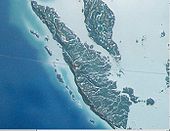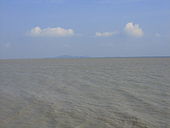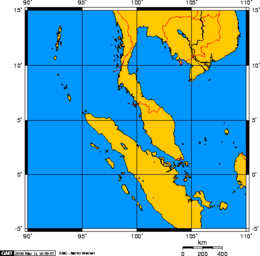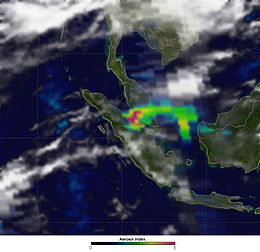
Strait of Malacca
Did you know...
This Schools selection was originally chosen by SOS Children for schools in the developing world without internet access. It is available as a intranet download. Do you want to know about sponsoring? See www.sponsorachild.org.uk
1.43°N 102.89°E The Strait of Malacca is a narrow, 805 km (500 mile) stretch of water between Peninsular Malaysia (West Malaysia) and the Indonesian island of Sumatra. It is named after the state of Malacca, Malaysia.
Economic importance
From an economic and strategic perspective the Strait of Malacca is one of the most important shipping lanes in the world.
The strait is the main shipping channel between the Indian Ocean and the Pacific Ocean, linking major Asian economies such as India, China, Japan, South Korea, and Taiwan. Over 50,000 vessels pass through the strait per year, carrying about one-quarter of the world's traded goods including oil, Chinese manufactures, and Indonesian coffee.
About a quarter of all oil carried by sea pass through the strait, mainly from Persian Gulf suppliers to Asian markets such as China, Japan, and South Korea. In 2006, an estimated 15 million barrels per day (2,400,000 m3/d) were transported through the strait.
The maximum size of a vessel that can make passage through the Strait is referred to as Malaccamax. The strait is not deep enough (at 25 metres or 82 feet) to permit some of the largest ships (mostly oil tankers) to use it. A ship that exceeds Malaccamax will typically use the Lombok Strait, Makassar Strait, Sibutu Passage and Mindoro Strait instead. At Phillips Channel near Singapore, the Strait of Malacca narrows to 2.8 km (1.5 nautical miles) wide, creating one of the world's most significant traffic chokepoints.
Shipping hazards
Piracy in the strait has risen in recent years. There were about 25 attacks on vessels in 1994, 220 in 2000, and just over 150 in 2003 (one-third of the global total).
After attacks rose again in the first half of 2004, the Malaysian, Indonesian and Singaporean navies stepped up their patrols of the area in July 2004.
There are 34 shipwrecks, some dating to the 1880s, in the Traffic Separation Scheme (TSS), the channel for commercial ships. These pose a collision hazard in the narrow and shallow Strait.
Another risk is the yearly haze caused by raging bush fires in Sumatra. It can reduce visibility to 200 metres (660 ft), forcing ships to slow down in the busy strait. Ships longer than 350 metres (1,150 ft) routinely use the strait.
Proposals to relieve the strait
Thailand has developed several plans to diminish the economic significance of the strait. The Thai government has over the course of its history several times proposed to cut a canal through the Isthmus of Kra, saving around 960 km (600 miles) from the journey from Indian Ocean to the Pacific. This would also cut Thailand in two, further isolating the separatist Muslim majority in Pattani. China has offered to cover the costs, according to a report leaked to The Washington Times in 2004. Nevertheless, and despite the support of several Thai politicians, the prohibitive financial and ecological costs suggest that no such canal will go ahead.
A second alternative is to build a pipeline across the isthmus to carry oil to ships waiting on the other side. Proponents say it would cut the cost of oil delivery to Asia by about $0.50/barrel ($3/m³). Myanmar has also made a similar pipeline proposal. There is also a proposal to pipe crude from the Middle East to Xinjiang, China. Building began in October 2004.
Early sea routes


Early traders from Egypt, Rome, Arabia, Africa, Turkey, Persia, and India used to reach the Malaysian state of Kedah before arriving at Guangzhou. Kedah served as a western port on the Malay Peninsula. These traders sailed to Kedah via the monsoon winds between June through November. They returned between December through May. Kedah provided accommodations, porters, small vessels, bamboo rafts, elephants, and also tax collections for goods to be transported over land toward the eastern states of the Malay Peninsula like Kelantan. Ships from China came to trade at these eastern trading posts and ports. Kedah and Funan were famous ports through the 6th century, before shipping began to utilize the Strait of Malacca itself as a trade route.


